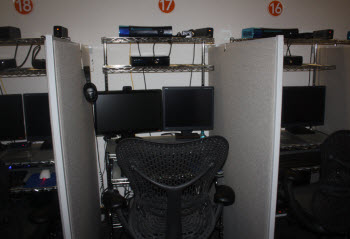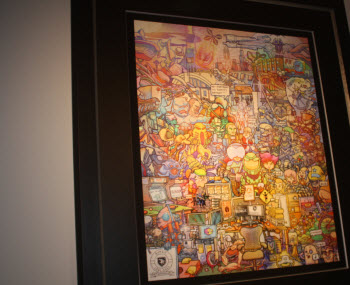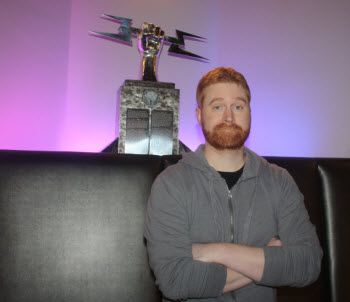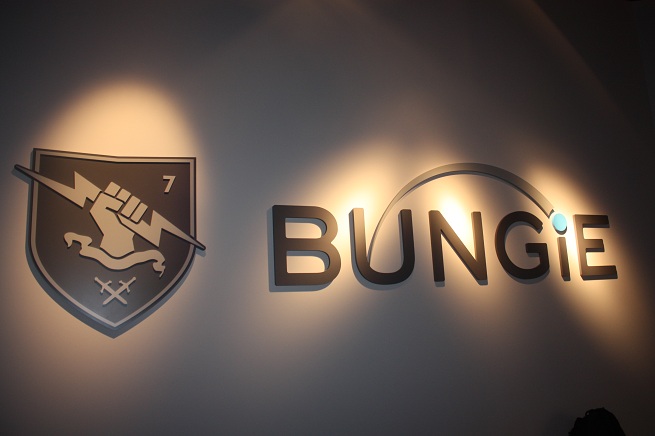Little by little, Bungie is opening up. The company has had to keep a lot of secrets, especially since it split from Microsoft in 2009 and began working on a top-secret project. We now know that the secret, code-named Tiger, is a new game series called Destiny.
 A visit to Bungie’s headquarters is an enviable journey. It’s like going to Oz and seeing the man behind the curtain. Gamers and budding developers would love to get a foot in the door — and perhaps make off with a souvenir. But having been there, I can tell you it’s pretty secure place. Fans have to keep out, but the whole place seems like it is built in the service of fans, like a physical homage to Halo and the company’s next big project.
A visit to Bungie’s headquarters is an enviable journey. It’s like going to Oz and seeing the man behind the curtain. Gamers and budding developers would love to get a foot in the door — and perhaps make off with a souvenir. But having been there, I can tell you it’s pretty secure place. Fans have to keep out, but the whole place seems like it is built in the service of fans, like a physical homage to Halo and the company’s next big project.
After a couple of leaks spilled the beans, Bungie acknowledged Destiny and said it would make a series of games over the next ten years, all to be published by Activision. For the first time since the Halo series started more than a decade ago, the new game series will be multi-platform, publishing on platforms such as the PlayStation 3 and PlayStation 4, not to mention the next Xbox and perhaps the PC.
We recently interviewed Pete Parsons, chief operating officer, about what it’s like to work at Bungie. Eric Osborne, community manager and writer at Bungie, led me on a tour through the company’s 80,000-square-feet headquarters in Bellevue, Wash., a suburb of Seattle. The place has no signs visible from the street, and you would never guess that it is housed inside a shopping mall in an office park. It used to be a theater complex and a bowling alley. This is the place where a team was willing to bet on the future and walk away from a multibillion-dollar game property.
A Halo museum, invaded by the Sexy Sax Man

The past is in the downstairs, where the former bowling alley was. Security is tight.
In fact, the day before I got there, two security officers had to escort a woman who was breaking the rules by trying to talk with every employee who exited the building. She wanted speakers for her class, and she also wanted to find out how her son could get work at Bungie. A few days earlier, a guy named Sexy Sax Man burst in to play music, and he got thrown out too.
Osborne says that the downstairs area is where they show fans who come into the building during shows such as Penny Arcade’s PAX event. During such times, dozens of fans mill about the entrance, hoping for a peek inside.
Just past the lobby, the downstairs hallway leads to a series of rooms: an arcade game room and interview rooms. In those interview rooms, a potential new hire could spend a whole day, being interviewed by one Bungie staffer after another. Bungie contends it has never lowered its standards for hiring. The hallway itself is littered with Halo paraphernalia on the walls and behind glass cases. Props from marketing campaigns of years past sit around.
A 3o-foot glass case houses a bunch of Halo toys and life-size replicas of weapons. Another glass case holds the trophies — all of the awards, like Halo’s first million games shipped. A big metallic award with a lightning bolt sits above a big couch. Nearby is a theater where Bungie entertained the gaggle of press that recently came to see Destiny. We were in there all alone, lucky to have our own private tour. The theater seems way too big for our small group. It has seating for 80.
 Further down the crooked hallway is the Laboratorium, where a bunch of cubicles are equipped with game machines, monitors, and webcams. The team shoots video of players as they play snippets of the upcoming game. They gauge the reactions and emotions of the players. The team can even do eye-tracking, or monitoring which part of the screen the player is looking at. If those players get lost in a maze, the team goes back to designing something better.
Further down the crooked hallway is the Laboratorium, where a bunch of cubicles are equipped with game machines, monitors, and webcams. The team shoots video of players as they play snippets of the upcoming game. They gauge the reactions and emotions of the players. The team can even do eye-tracking, or monitoring which part of the screen the player is looking at. If those players get lost in a maze, the team goes back to designing something better.
Still further down the crooked hallway is the Spandex Palace. This is the motion-capture studio, a big empty space with floor mats and rigs that mount 22 motion-capture cameras. The team can capture all movement in the room, including that of performance actors as they speak their lines. The cameras record the movements in 3D and store them in digital form.

Game artists can take the entire performance — the body movements, the lip movements, the voice acting — and bring it directly into the game. They can then enhance it with their digital artistry, so it looks nothing like actors in spandex and more like alien creatures and space marines. The fact that Bungie has its own mo-cap studio shows it is working on the high end; many other studios hire motion-capture experts to do the work for them.
One painting on the wall, by Seattle artist Ken Taya, stands out. Created for Bungie’s 20th anniversary, it has a bunch of events from the company’s history woven into a single, overcrowded painting. At the bottom is a chair, and by the chair is a tail. It is a tiger’s tail, and it was a hint about what was coming up.
There’s a snack room with all sorts of free goodies. Bungie employees get a lot of free food. And executives like Parsons go out to lunch with most new employees, so they can get a download on what works and what doesn’t.
“We have a free-lunch program so we can make sure new employees meet older employees,” Parsons said. “We even have something called Bungie University where there’s more than 60 hours worth of video. Starting from when we kicked off Destiny to the team at large in August 2009, you can watch all the way until now.”
There’s also something called Tiger University, which brings new employees up to speed on the new project.
Halo left behind
 These are all artifacts of a universe left behind. In 2009, Microsoft formed 343 Industries, a new game studio inside Microsoft that is dedicated to the Halo legacy. 343 Industries made last fall’s Halo 4, the beginning of a new Master Chief trilogy. That wasn’t easy for Bungie to do, considering Halo has now sold more than 50 million units and generated billions of dollars in revenue. The Bungie veterans moved on to a new headquarters and to Destiny.
These are all artifacts of a universe left behind. In 2009, Microsoft formed 343 Industries, a new game studio inside Microsoft that is dedicated to the Halo legacy. 343 Industries made last fall’s Halo 4, the beginning of a new Master Chief trilogy. That wasn’t easy for Bungie to do, considering Halo has now sold more than 50 million units and generated billions of dollars in revenue. The Bungie veterans moved on to a new headquarters and to Destiny.
But such was the will of Jason Jones, the remaining founder of Bungie. He began working on prototypes for a new game, an always-connected first-person shooter in a persistent online world. There are 350 people following Jones, many of them acolytes like Parsons once was.
“As naïve as this may sound, if Jason believes in something and he’s ready to go for it, I’m in,” Parsons (pictured left) said in the interview with GamesBeat. “No joke, I still walk in the door every day and think, ‘Who gets to do this? This is awesome, to be a part of this thing.’ Even when I’m having a shitty day, I feel that way. There are so many other things I could do that, for me, wouldn’t be as satisfying or as interesting. They might be enriching. They might satisfy some level of my curiosity. They might be exciting. But there’s something about these people and this place.”
Parsons had no qualms about leaving Halo and moving on to something new. He saw a concept image that Jones worked on with an artist. Parsons took a look at that image and said, “That’s it. That’s the game. That’s the idea. That’s a place that I want to be.”
The full team rolled off of Halo: Reach in 2010. Then Bungie struck its deal with Activision to publish Destiny.

The Destiny place
The place for Destiny is upstairs, behind a second set of security doors (in case you’re a rabid fan and somehow you get past all the security).
It has a climbing wall, so that the developers can get a short nature fix scaling a big rock, rather than going beyond the city borders to the misty falls of the Snoqualmie river or other beautiful natural terrain surrounding Seattle.
One room was full of playtesters. No cameras were allowed there. After all, they were trying out the game on a variety of consoles, including something that looked like a PlayStation 3. That was the part of the tour where I couldn’t linger. It’s close to a kitchen, so the playtesters in particular can stay well fed.
There’s a room called the Fish Tank for creating trailers. People like Jim McQuillan, director of visual identity at Bungie, get stuck in there for days in the time leading up to big reveals. Bungie keeps that team on the inside because it wants to tell its own story.
The audio team has its own rooms, for sound-proof experimentation. Among them is the office for Marty O’Donnell, who created the memorable, haunting music of Halo which sounded almost religious, like a Gregorian chant. O’Donnell’s office is called the Ivory Tower. I don’t think he has topped the music from the first Halo, but, dammit, he deserves an office like that and his giant keyboard too.
At a table in the center of the room are a bunch of posters, art work, and other souvenirs that fans have sent in. Members of the team autograph the work so that the community managers can return them. Often, the wares are auctioned off for charities.
Also in the middle of the floor is a sign that says “Someone talked.” It’s a reminder of the damage that can happen if someone leaks any secrets to the press, as happened earlier this year.
“You have to be careful what you say out there,” Osborne said. “It’s awesome to be able to talk about it and get out on the social networks.”

The view from above
There’s an upstairs to the upstairs. A bunch of conference rooms line the walls. Some have glass walls so you can see who is meeting inside. But one room, called the Hive, is enclosed on all sides. That’s where some of the most top-secret of the top-secret meetings take place.
 Many of the rooms were set aside for the Bungie Pentathlon, an internal event where players roam around the building and can play a bunch of old games.
Many of the rooms were set aside for the Bungie Pentathlon, an internal event where players roam around the building and can play a bunch of old games.
From above, you can see the whole floor where the 350 or so developers work. It’s about a football field in length. Every desk has wheels, and atop each one are two or three monitors. The place has bright, high windows, but most of the room is poorly lit. In the dark, the artists work better. They occasionally look up to see who is gawking at them and trying to see what is on their screens.
“They sometimes feel like they are in an aquarium,” Osborne (pictured left) said.
The whole team is focused on just one game. Or series of games.
“That means there are no walls, no cabals,” Osborne said.
One section belongs to the user interface team. Another is for server engineers. There are world designers, story teams, 3D artists, concept artists, and testers. But everybody is the same room. Like a family, the Bungie people say.
Big posters hang from the ceiling with Destiny art. The company unfurled them on the last Bungie Day, when the whole company takes over a picnic area and celebrates together.
Near a snack area hangs a big punching bag, the kind that hangs from a bar in a gym. People can walk over to it any time and blow off some steam, punching the hell out of it. Some people have knocked it off the bar entirely. Rumor was it was Harold Ryan, chief executive of Bungie.

Living up to expectations
Bungie.net attracted fans, such as Osborne, who grew up in the fan community. He was offered a job to join it and drove across the country with everything he owned in a car. Back in 2004, with the debut of Halo 2, the company launched Bungie.net. It was a small effort with just a couple of people. They created things like the stats that are now commonplace in first-person shooter online games, as a measure of a player’s stature. Now the Bungie.net section is a big one, with everybody sitting together. Osborne smiles as he acknowledges that Halo changed his life.
Parsons said, “Bungie.net started in 2004, and it was revolutionary. Now we’re saying, ‘How do we make sure that we can connect you, wherever you are and whatever your mood, to the Destiny universe?’ That meant a big exploration of mobile. I think they showed you the user-testing lab next door. The very first thing that was tested in that lab was mobile. We’ve made some big investments there, because we think that, as awesome as stats and groups and messaging and all those things are, we just think there is so much more there. When we’re building a universe that has so many more stories and so much more depth, there are too many stories to tell just inside of that.”
OK, to me, that sounds like we’re going to see mobile versions of Destiny. Somewhere on the floor is the team of Bungie Aerospace, a mobile-focused team that was born from experiments in user testing.
At Bungie.net, the job is to stay in touch with millions of fans. The company will extend the experience to mobile in the future. With Destiny, it will be hard to carry on a conversation with a million people at a time. The Bungie.net team is trying to figure that out ahead of time. Essentially, the community will be deputized to curate its own experience and vote on what rises to the top.
 In closing
In closing
Our tour ended with our interview in the big theater, with Parsons. As the company builds its games and moves forward, Parsons has to think about keeping the company’s culture the same.
“I think it’s more about an evolution of the culture,” he said. “How do we keep Bungie Bungie? When you do that, not everything is going to make it. Some things are going to need to change. You’re going to need to bring new things into the fold, and some things are going to go away.”
Parsons said that he absorbs a lot of the feedback from new employees and takes them to the rest of the team.
“We take those ideas seriously,” he said. “I want to do it in that four to eight weeks because that’s before they become cynical and jaded. [Laughs] You want to get that perspective. It’s great to hear the feedback, including that Bungie has remained a place where, whether you’ve been around for more than a decade or whether you’re just a few weeks in, what you do matters.”
VentureBeat's mission is to be a digital town square for technical decision-makers to gain knowledge about transformative enterprise technology and transact. Learn More

